
Paraíba
Encyclopedia
Paraíba
Paraíba (Tupi: pa'ra a'íba: "bad to navigation"; Brazilian Portuguese
pronunciation: (paɾaˈiba) is a state of Brazil
. It is located in the Brazilian Northeast, and is bordered by Rio Grande do Norte
to the north, Ceará
to the west, Pernambuco
to the south and the Atlantic Ocean
to the east. Paraíba is the third most densely populated state of the Northeast; João Pessoa
, the sea-bordered state capital, and Campina Grande
, in the interior, rank among the fifteen-largest municipalities in the Northeast of Brazil.
Paraíba is most populated along the Atlantic coast, which extends as far as Ponta do Seixas, the easternmost point of the Americas
. The state is a touristic and industrial hotspot; it is known for its cultural heritage, amenable climate and geographical features, ranging from the seaside beaches to the Borborema Plateau
. It is named after the Paraíba river
.
Some of the most notable Brazilian writers and poets are from Paraíba like Augusto dos Anjos
, José Américo de Almeida
, José Lins do Rego
and Pedro Américo
, the last being also known for his historical paintings.
settlers from Pernambuco
founded Filipéia de Nossa Senhora das Neves (today João Pessoa) at the mouth of the Paraíba do Norte River
.
The area soon proved perfect for sugar
production, with the French
, the Dutch
and the Portuguese all constantly fighting to control the Paraíba region to grow the lucrative sugarcane
in. The fortress of Santa Catarina, near João Pessoa, was built to protect the city from the Dutch, who soon became a threat to Portuguese supremacy in Brazil.
In late 1989 a team led by gemstone
prospector Heitor Dimas Barbosa uncovered in a small mountain range what some consider to be the finest tourmaline
crystals ever found. A trace of copper
gives the tourmalines a vivid turquoise
color that had never been seen before in the gems, and is sometimes referred to as "neon".
The "neon" paraiba tourmaline
, a vivid blue and blue green, has also been found in other deposits close to the Batalha mine of Barbosa, and also in the neighboring state of Rio Grande do Norte. The bright colors of this tourmaline are due to the presence of copper. Around 2000, a similar copper-containing tourmaline was found in Nigeria, although the colors are not as intense. Around 2005, beautiful crystals of copper-containing tourmaline were found in Mozambique.
Initially, the nomenclature for this tourmaline was "Paraíba tourmaline". Note the capitalization and the accent on the "i". In 2006, the LMHC (Laboratory Manual Harmonization Committee) agreed that "paraiba" should refer to a variety of tourmaline, and not indicate a geographic origin. Note "paraiba" is not capitalized, and does not have an accent on the "i". For more information on paraiba tourmaline, see article on tourmaline
. The term "paraiba tourmaline" may now refer to gems found in Brazil, Nigeria, and Mozambique that contain copper and have the characteristic blue-green color.
census as of 2008, there were 3,794,000 people residing in the state, with a population density of 64.2 inh./km².
Other numbers include: Urbanization
tax: 76.3% (2006), Population growth
: 0.8% (1991–2000) and House
s: 987,000 (2006).
The last PNAD (National Research for Sample of Domiciles) census of 2008 revealed the following numbers: 2,172,000 Brown (Multiracial) people (57.24%), 1,412,000 White
(37.21%), 196,000 Black
(5.16%), 8,000 Amerindian
(0.22%), 5,000 Asian
(0.14%).
Among people of mixed ancestry
the White and Amerindian combination is the most prevalent one (the so-called "caboclos"), followed by mulatto
s and then multiracial
people (White, Black and Amerindian ancestry combined altogether).
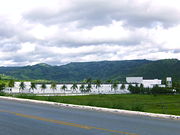 The service sector is the largest component of GDP at 56.5%, followed by the industrial sector at 33.1%. Agriculture
The service sector is the largest component of GDP at 56.5%, followed by the industrial sector at 33.1%. Agriculture
represents 10.4%, of GDP (2004). Paraíba exports: woven
of cotton
36.3%, footwear
es 20.1%, sugar
and alcohol
10.8%, fish
and crustacean
9.7%, sisal
7%, cotton
6.6% (2002).
Share of the Brazilian economy: 0.8% (2004).
The Paraíba economy is largely based upon the making of shoe
s and other leather
products, the raising of cattle
for beef
, and sugarcane
, corn
. Though historically sugarcane has dominated the Paraíba agricultural
sector, pineapple
, corn
, and beans cultivation are also widespread. The other important economical sector in the state is tourism, especially the state urban and unspoilt beaches, ecoturism and festivals such as "carnaval" and "São João."
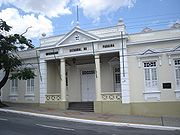 Portuguese
Portuguese
is the official and only language spoken in the state and thus the primary language taught in schools. Minor dialect
al differences regarding other Brazilian varieties are mainly phonological (Northeastern accent).
English
and Spanish
are part of the official high school
curriculum.
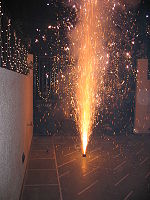 Festa Junina
Festa Junina
was introduced to Northeastern Brazil
by the Portuguese
for whom St John's day (also celebrated as Midsummer
Day in several Europe
an countries), on the 24th of June, is one of the oldest and most popular celebrations of the year. Differently, of course, from what happens on the European Midsummer
Day, the festivities in Brazil do not take place during the summer solstice
but during the tropical winter solstice
. The festivities traditionally begin after the 12th of June, on the eve of St Anthony's day, and last until the 29th, which is Saint Peter's day. During these fifteen days, there are bonfires, fireworks
, and folk dancing in the streets (step names are in French, which shows the mutual influences between court life and peasant culture in the 17th, 18th, and 19th-century Europe). Once exclusively a rural festival, today in Brazil, it is largely a city festival during which people joyfully and theatrically mimic peasant stereotypes and clichés in a spirit of jokes and good times. Typical refreshments and dishes are served. It should be noted that, like during Carnival, these festivities involve costume-wearing (in this case, peasant costumes), dancing, heavy drinking, and visual spectacles (fireworks display and folk dancing), such as what happens on Midsummer
and St John's Day in Europe,and bonfires are a central part of these festivities in Brazil.
time in Brazil
. Rich and poor alike forget their cares as they party in the streets.
 Located in the municipality of Bayeux, eight kilometers from downtown João Pessoa
Located in the municipality of Bayeux, eight kilometers from downtown João Pessoa
, Presidente Castro Pinto International Airport is currently undergoing expansion and remodeling work, which will raise the terminal’s annual capacity to 860 thousand passengers.
The airport is well located in relation to obstacles because it covers an area roughly 65 meters above sea level and is sufficiently distant from urban areas or large real estate developments.
The surrounding area is sparsely populated, with large open spaces. The existing developments are industrial with some small weekend country houses. There is no rough terrain or tall buildings nearby creating obstacles for takeoffs and landings.
The airport also is blessed with excellent climatic conditions for air operations. Moreover, within its approach radius there are no obstacles that can hinder or create risk for local air traffic. Named for a past president (former name for governors) of Paraíba, Castro Pinto, the airport operates round the clock.
The current passenger terminal, built in an area of 8,947.72 square meters, has two levels, gardens and ample vehicle parking. It has all the expected amenities: arrival and departure lounges, a main concourse, check-in counters, baggage storage lockers, airline counters, snack bar/restaurant, tourist information booth, car rental agencies, taxi
service and private parking.
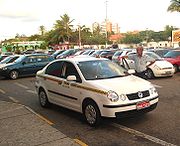 Located in the interior of the state of Paraíba, in the city of Campina Grande
Located in the interior of the state of Paraíba, in the city of Campina Grande
, João Suassuna Airport was remodeled in 2003, receiving a new terminal with capacity of 250 thousand passengers a year.
The old building was demolished and on the site a new facility was built holding nine shops, the main concourse, arrival and departure lounges, VIP lounge, bathrooms, mezzanine and a diaper-changing area.
The terminal area was increased to 2,500 square meters. The boarding area has 350 square meters and the parking lot has spaces for 180 cars.
This expansion benefited the city both economically and from the standpoint of tourism
. With the possibility for new flights, the air cargo movement will be able to grow, along with the number of tourists coming to attend the city’s famous São João
Festival.
A panel measuring 17 by 3.5 meters in the front of the building carries a poem by the Paraíban writer Ariano Suassuna, in homage to his father, for whom the airport is named. Three more artworks are on permanent display in the passenger terminal.
for "I deny", referring to the protests that erupted in the 1920s in Paraíba, supported by state governor João Pessoa Cavalcânti de Albuquerque
, to the appointment of Júlio Prestes
as the President of Brazil
. João Pessoa joined the alliance
for the overthrow of the federal government, which successfully conducted Getúlio Vargas
to Presidency. The rebellion events eventually led to the murder of João Pessoa, although there is debate regarding the reasons of the murder, if personal, political or both.
According to the official government site of the state of Paraíba, the red stands for the blood due to the assassination of João Pessoa; the black represents the mourning following the assassination.
In colloquial usage "nego" is a variant of "negro", meaning "black", or Afro-Brazilian
.

contestant Wagner Fiuza-Carrilho.
List of cities in Brazil (all cities and municipalities)
Paraíba (Tupi: pa'ra a'íba: "bad to navigation"; Brazilian Portuguese
Brazilian Portuguese
Brazilian Portuguese is a group of Portuguese dialects written and spoken by most of the 190 million inhabitants of Brazil and by a few million Brazilian emigrants, mainly in the United States, United Kingdom, Portugal, Canada, Japan and Paraguay....
pronunciation: (paɾaˈiba) is a state of Brazil
Brazil
Brazil , officially the Federative Republic of Brazil , is the largest country in South America. It is the world's fifth largest country, both by geographical area and by population with over 192 million people...
. It is located in the Brazilian Northeast, and is bordered by Rio Grande do Norte
Rio Grande do Norte
Rio Grande do Norte is one of the states of Brazil, located in the northeastern region of the country, occupying the northeasternmost tip of the South American continent. Because of its geographic position, Rio Grande do Norte has a strategic importance. The capital and largest city is Natal...
to the north, Ceará
Ceará
Ceará is one of the 27 states of Brazil, located in the northeastern part of the country, on the Atlantic coast. It is currently the 8th largest Brazilian State by population and the 17th by area. It is also one of the main touristic destinations in Brazil. The state capital is the city of...
to the west, Pernambuco
Pernambuco
Pernambuco is a state of Brazil, located in the Northeast region of the country. To the north are the states of Paraíba and Ceará, to the west is Piauí, to the south are Alagoas and Bahia, and to the east is the Atlantic Ocean. There are about of beaches, some of the most beautiful in the...
to the south and the Atlantic Ocean
Atlantic Ocean
The Atlantic Ocean is the second-largest of the world's oceanic divisions. With a total area of about , it covers approximately 20% of the Earth's surface and about 26% of its water surface area...
to the east. Paraíba is the third most densely populated state of the Northeast; João Pessoa
João Pessoa
João Pessoa , is the capital city of the state of Paraíba, was founded in 1585 and sometimes called the city where the sun rises first, is a Brazilian city and the easternmost city in the Americas at 34º47'38"W, 7º9'28"S. Local residents call its easternmost point Ponta do Seixas. It is also...
, the sea-bordered state capital, and Campina Grande
Campina Grande
Campina Grande is the second most populous Brazilian city in the State of Paraíba after João Pessoa, the capital. It is considered to be the most important city of the Northeastern Brazilian subregion called agreste. It is considered one of the main industrial, technological and educational...
, in the interior, rank among the fifteen-largest municipalities in the Northeast of Brazil.
Paraíba is most populated along the Atlantic coast, which extends as far as Ponta do Seixas, the easternmost point of the Americas
Americas
The Americas, or America , are lands in the Western hemisphere, also known as the New World. In English, the plural form the Americas is often used to refer to the landmasses of North America and South America with their associated islands and regions, while the singular form America is primarily...
. The state is a touristic and industrial hotspot; it is known for its cultural heritage, amenable climate and geographical features, ranging from the seaside beaches to the Borborema Plateau
Borborema Plateau
The Borborema Plateau is a plateau in northeastern Brazil which extends across the states of Pernambuco, Paraíba, and Rio Grande do Norte....
. It is named after the Paraíba river
Paraíba do Norte River
The Paraíba do Norte River, also known simply as the Paraíba River, is a river in Paraíba state of northeastern Brazil. The river originates in the Borborema Plateau, and it flows northeast to empty into the Atlantic Ocean north of João Pessoa, the state capital....
.
Some of the most notable Brazilian writers and poets are from Paraíba like Augusto dos Anjos
Augusto dos Anjos
Augusto de Carvalho Rodrigues dos Anjos was a Brazilian poet and professor. His poems speak mostly of sickness and death, and are considered to forerun the Modernism in Brazil....
, José Américo de Almeida
José Américo de Almeida
José Américo de Almeida was a Brazilian writer, a politician, a lawyer and a teacher.- Bibliography :* Reflexões de um Cabra, 1922* A Paraíba e seus Problemas, 1923* A Bagaceira, 1928...
, José Lins do Rego
José Lins do Rego
José Lins do Rego Cavalcanti was a Brazilian novelist most known for his semi-autobiographical "sugarcane cycle." These novels were the basis of films that had distribution in the English speaking world...
and Pedro Américo
Pedro Américo
Pedro Américo de Figueiredo e Melo was one of the most important academic painters of Brazil. He was also a writer and a teacher....
, the last being also known for his historical paintings.
History
In the mid-16th century, PortuguesePortugal
Portugal , officially the Portuguese Republic is a country situated in southwestern Europe on the Iberian Peninsula. Portugal is the westernmost country of Europe, and is bordered by the Atlantic Ocean to the West and South and by Spain to the North and East. The Atlantic archipelagos of the...
settlers from Pernambuco
Pernambuco
Pernambuco is a state of Brazil, located in the Northeast region of the country. To the north are the states of Paraíba and Ceará, to the west is Piauí, to the south are Alagoas and Bahia, and to the east is the Atlantic Ocean. There are about of beaches, some of the most beautiful in the...
founded Filipéia de Nossa Senhora das Neves (today João Pessoa) at the mouth of the Paraíba do Norte River
Paraíba do Norte River
The Paraíba do Norte River, also known simply as the Paraíba River, is a river in Paraíba state of northeastern Brazil. The river originates in the Borborema Plateau, and it flows northeast to empty into the Atlantic Ocean north of João Pessoa, the state capital....
.
The area soon proved perfect for sugar
Sugar
Sugar is a class of edible crystalline carbohydrates, mainly sucrose, lactose, and fructose, characterized by a sweet flavor.Sucrose in its refined form primarily comes from sugar cane and sugar beet...
production, with the French
France
The French Republic , The French Republic , The French Republic , (commonly known as France , is a unitary semi-presidential republic in Western Europe with several overseas territories and islands located on other continents and in the Indian, Pacific, and Atlantic oceans. Metropolitan France...
, the Dutch
Netherlands
The Netherlands is a constituent country of the Kingdom of the Netherlands, located mainly in North-West Europe and with several islands in the Caribbean. Mainland Netherlands borders the North Sea to the north and west, Belgium to the south, and Germany to the east, and shares maritime borders...
and the Portuguese all constantly fighting to control the Paraíba region to grow the lucrative sugarcane
Sugarcane
Sugarcane refers to any of six to 37 species of tall perennial grasses of the genus Saccharum . Native to the warm temperate to tropical regions of South Asia, they have stout, jointed, fibrous stalks that are rich in sugar, and measure two to six metres tall...
in. The fortress of Santa Catarina, near João Pessoa, was built to protect the city from the Dutch, who soon became a threat to Portuguese supremacy in Brazil.
In late 1989 a team led by gemstone
Gemstone
A gemstone or gem is a piece of mineral, which, in cut and polished form, is used to make jewelry or other adornments...
prospector Heitor Dimas Barbosa uncovered in a small mountain range what some consider to be the finest tourmaline
Tourmaline
Tourmaline is a crystal boron silicate mineral compounded with elements such as aluminium, iron, magnesium, sodium, lithium, or potassium. Tourmaline is classified as a semi-precious stone and the gem comes in a wide variety of colors...
crystals ever found. A trace of copper
Copper
Copper is a chemical element with the symbol Cu and atomic number 29. It is a ductile metal with very high thermal and electrical conductivity. Pure copper is soft and malleable; an exposed surface has a reddish-orange tarnish...
gives the tourmalines a vivid turquoise
Turquoise
Turquoise is an opaque, blue-to-green mineral that is a hydrous phosphate of copper and aluminium, with the chemical formula CuAl648·4. It is rare and valuable in finer grades and has been prized as a gem and ornamental stone for thousands of years owing to its unique hue...
color that had never been seen before in the gems, and is sometimes referred to as "neon".
The "neon" paraiba tourmaline
Tourmaline
Tourmaline is a crystal boron silicate mineral compounded with elements such as aluminium, iron, magnesium, sodium, lithium, or potassium. Tourmaline is classified as a semi-precious stone and the gem comes in a wide variety of colors...
, a vivid blue and blue green, has also been found in other deposits close to the Batalha mine of Barbosa, and also in the neighboring state of Rio Grande do Norte. The bright colors of this tourmaline are due to the presence of copper. Around 2000, a similar copper-containing tourmaline was found in Nigeria, although the colors are not as intense. Around 2005, beautiful crystals of copper-containing tourmaline were found in Mozambique.
Initially, the nomenclature for this tourmaline was "Paraíba tourmaline". Note the capitalization and the accent on the "i". In 2006, the LMHC (Laboratory Manual Harmonization Committee) agreed that "paraiba" should refer to a variety of tourmaline, and not indicate a geographic origin. Note "paraiba" is not capitalized, and does not have an accent on the "i". For more information on paraiba tourmaline, see article on tourmaline
Tourmaline
Tourmaline is a crystal boron silicate mineral compounded with elements such as aluminium, iron, magnesium, sodium, lithium, or potassium. Tourmaline is classified as a semi-precious stone and the gem comes in a wide variety of colors...
. The term "paraiba tourmaline" may now refer to gems found in Brazil, Nigeria, and Mozambique that contain copper and have the characteristic blue-green color.
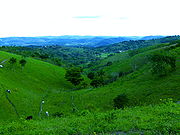 |
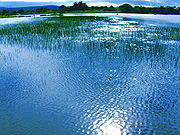 |
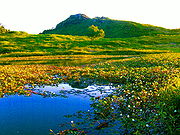 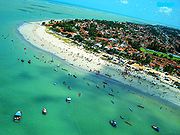 |
Demographics
According to the IBGEIBGE
The Brazilian Institute of Geography and Statistics or IBGE , is the agency responsible for statistical, geographic, cartographic, geodetic and environmental information in Brazil...
census as of 2008, there were 3,794,000 people residing in the state, with a population density of 64.2 inh./km².
Other numbers include: Urbanization
Urbanization
Urbanization, urbanisation or urban drift is the physical growth of urban areas as a result of global change. The United Nations projected that half of the world's population would live in urban areas at the end of 2008....
tax: 76.3% (2006), Population growth
Population growth
Population growth is the change in a population over time, and can be quantified as the change in the number of individuals of any species in a population using "per unit time" for measurement....
: 0.8% (1991–2000) and House
House
A house is a building or structure that has the ability to be occupied for dwelling by human beings or other creatures. The term house includes many kinds of different dwellings ranging from rudimentary huts of nomadic tribes to free standing individual structures...
s: 987,000 (2006).
The last PNAD (National Research for Sample of Domiciles) census of 2008 revealed the following numbers: 2,172,000 Brown (Multiracial) people (57.24%), 1,412,000 White
White Brazilian
White Brazilians make up 48.4% of Brazil's population, or around 92 million people, according to the IBGE's 2008 PNAD . Whites are present in the entire territory of Brazil, although the main concentrations are found in the South and Southeastern parts of the country...
(37.21%), 196,000 Black
Afro-Brazilian
In Brazil, the term "preto" is one of the five categories used by the Brazilian Census, along with "branco" , "pardo" , "amarelo" and "indígena"...
(5.16%), 8,000 Amerindian
Indigenous peoples in Brazil
The Indigenous peoples in Brazil comprise a large number of distinct ethnic groups who inhabited the country prior to the European invasion around 1500...
(0.22%), 5,000 Asian
Asian Brazilian
An Asian Brazilian is is a Brazilian citizen of full or partial Asian ancestry, who remains culturally connected to Asia, or an Asian-born person permanently residing in Brazil. Brazil received many immigrants from Asia, both from Middle East and East Asia...
(0.14%).
Among people of mixed ancestry
Brown
Brown is a color term, denoting a range of composite colors produced by a mixture of orange, red, rose, or yellow with black or gray. The term is from Old English brún, in origin for any dusky or dark shade of color....
the White and Amerindian combination is the most prevalent one (the so-called "caboclos"), followed by mulatto
Mulatto
Mulatto denotes a person with one white parent and one black parent, or more broadly, a person of mixed black and white ancestry. Contemporary usage of the term varies greatly, and the broader sense of the term makes its application rather subjective, as not all people of mixed white and black...
s and then multiracial
Multiracial
The terms multiracial and mixed-race describe people whose ancestries come from multiple races. Unlike the term biracial, which often is only used to refer to having parents or grandparents of two different races, the term multiracial may encompass biracial people but can also include people with...
people (White, Black and Amerindian ancestry combined altogether).
Statistics
- Vehicles: 432,337 (March/2007);
- Mobile phoneMobile phoneA mobile phone is a device which can make and receive telephone calls over a radio link whilst moving around a wide geographic area. It does so by connecting to a cellular network provided by a mobile network operator...
s: 1.5 million (April/2007) - TelephoneTelephoneThe telephone , colloquially referred to as a phone, is a telecommunications device that transmits and receives sounds, usually the human voice. Telephones are a point-to-point communication system whose most basic function is to allow two people separated by large distances to talk to each other...
s: 431 thousand (April/2007) - Cities: 223 (2007).
Economy

Agriculture
Agriculture is the cultivation of animals, plants, fungi and other life forms for food, fiber, and other products used to sustain life. Agriculture was the key implement in the rise of sedentary human civilization, whereby farming of domesticated species created food surpluses that nurtured the...
represents 10.4%, of GDP (2004). Paraíba exports: woven
Woven
A woven is a cloth formed by weaving. It only stretches in the bias directions , unless the threads are elastic. Woven cloth usually frays at the edges, unless measures are taken to counter this, such as the use of pinking shears or hemming.Woven fabrics are worked on a loom and made of many...
of cotton
Cotton
Cotton is a soft, fluffy staple fiber that grows in a boll, or protective capsule, around the seeds of cotton plants of the genus Gossypium. The fiber is almost pure cellulose. The botanical purpose of cotton fiber is to aid in seed dispersal....
36.3%, footwear
Footwear
Footwear consists of garments worn on the feet, for fashion, protection against the environment, and adornment. Being barefoot is commonly associated with poverty, but some cultures chose not to wear footwear at least in some situations....
es 20.1%, sugar
Sugar
Sugar is a class of edible crystalline carbohydrates, mainly sucrose, lactose, and fructose, characterized by a sweet flavor.Sucrose in its refined form primarily comes from sugar cane and sugar beet...
and alcohol
Alcohol
In chemistry, an alcohol is an organic compound in which the hydroxy functional group is bound to a carbon atom. In particular, this carbon center should be saturated, having single bonds to three other atoms....
10.8%, fish
Fish
Fish are a paraphyletic group of organisms that consist of all gill-bearing aquatic vertebrate animals that lack limbs with digits. Included in this definition are the living hagfish, lampreys, and cartilaginous and bony fish, as well as various extinct related groups...
and crustacean
Crustacean
Crustaceans form a very large group of arthropods, usually treated as a subphylum, which includes such familiar animals as crabs, lobsters, crayfish, shrimp, krill and barnacles. The 50,000 described species range in size from Stygotantulus stocki at , to the Japanese spider crab with a leg span...
9.7%, sisal
Sisal
Sisal is an agave that yields a stiff fibre traditionally used in making twine, rope and also dartboards. The term may refer either to the plant or the fibre, depending on context...
7%, cotton
Cotton
Cotton is a soft, fluffy staple fiber that grows in a boll, or protective capsule, around the seeds of cotton plants of the genus Gossypium. The fiber is almost pure cellulose. The botanical purpose of cotton fiber is to aid in seed dispersal....
6.6% (2002).
Share of the Brazilian economy: 0.8% (2004).
The Paraíba economy is largely based upon the making of shoe
Shoe
A shoe is an item of footwear intended to protect and comfort the human foot while doing various activities. Shoes are also used as an item of decoration. The design of shoes has varied enormously through time and from culture to culture, with appearance originally being tied to function...
s and other leather
Leather
Leather is a durable and flexible material created via the tanning of putrescible animal rawhide and skin, primarily cattlehide. It can be produced through different manufacturing processes, ranging from cottage industry to heavy industry.-Forms:...
products, the raising of cattle
Cattle
Cattle are the most common type of large domesticated ungulates. They are a prominent modern member of the subfamily Bovinae, are the most widespread species of the genus Bos, and are most commonly classified collectively as Bos primigenius...
for beef
Beef
Beef is the culinary name for meat from bovines, especially domestic cattle. Beef can be harvested from cows, bulls, heifers or steers. It is one of the principal meats used in the cuisine of the Middle East , Australia, Argentina, Brazil, Europe and the United States, and is also important in...
, and sugarcane
Sugarcane
Sugarcane refers to any of six to 37 species of tall perennial grasses of the genus Saccharum . Native to the warm temperate to tropical regions of South Asia, they have stout, jointed, fibrous stalks that are rich in sugar, and measure two to six metres tall...
, corn
Maize
Maize known in many English-speaking countries as corn or mielie/mealie, is a grain domesticated by indigenous peoples in Mesoamerica in prehistoric times. The leafy stalk produces ears which contain seeds called kernels. Though technically a grain, maize kernels are used in cooking as a vegetable...
. Though historically sugarcane has dominated the Paraíba agricultural
Agriculture
Agriculture is the cultivation of animals, plants, fungi and other life forms for food, fiber, and other products used to sustain life. Agriculture was the key implement in the rise of sedentary human civilization, whereby farming of domesticated species created food surpluses that nurtured the...
sector, pineapple
Pineapple
Pineapple is the common name for a tropical plant and its edible fruit, which is actually a multiple fruit consisting of coalesced berries. It was given the name pineapple due to its resemblance to a pine cone. The pineapple is by far the most economically important plant in the Bromeliaceae...
, corn
Maize
Maize known in many English-speaking countries as corn or mielie/mealie, is a grain domesticated by indigenous peoples in Mesoamerica in prehistoric times. The leafy stalk produces ears which contain seeds called kernels. Though technically a grain, maize kernels are used in cooking as a vegetable...
, and beans cultivation are also widespread. The other important economical sector in the state is tourism, especially the state urban and unspoilt beaches, ecoturism and festivals such as "carnaval" and "São João."
Education

Portuguese language
Portuguese is a Romance language that arose in the medieval Kingdom of Galicia, nowadays Galicia and Northern Portugal. The southern part of the Kingdom of Galicia became independent as the County of Portugal in 1095...
is the official and only language spoken in the state and thus the primary language taught in schools. Minor dialect
Dialect
The term dialect is used in two distinct ways, even by linguists. One usage refers to a variety of a language that is a characteristic of a particular group of the language's speakers. The term is applied most often to regional speech patterns, but a dialect may also be defined by other factors,...
al differences regarding other Brazilian varieties are mainly phonological (Northeastern accent).
English
English language
English is a West Germanic language that arose in the Anglo-Saxon kingdoms of England and spread into what was to become south-east Scotland under the influence of the Anglian medieval kingdom of Northumbria...
and Spanish
Spanish language
Spanish , also known as Castilian , is a Romance language in the Ibero-Romance group that evolved from several languages and dialects in central-northern Iberia around the 9th century and gradually spread with the expansion of the Kingdom of Castile into central and southern Iberia during the...
are part of the official high school
High school
High school is a term used in parts of the English speaking world to describe institutions which provide all or part of secondary education. The term is often incorporated into the name of such institutions....
curriculum.
Educational institutions
- Universidade Federal da Paraíba (UFPB) (Federal University of ParaíbaFederal University of ParaíbaThe Universidade Federal da Paraíba is a public university whose main campus is located in the city of João Pessoa, Paraíba, Brazil. Translating the name into English is discouraged by the university, however paraphrasing as Federal University of Paraíba is recommended by the university if necessary...
); - Universidade Federal de Campina Grande (UFCG) (Federal University of Campina GrandeFederal University of Campina GrandeThe Universidade Federal de Campina Grande, Brazil, generally known as UFCG, is a public university whose main campus is located in the city of Campina Grande, Paraíba, Brazil. Together with the Federal University of Paraíba, it is the main university of the state of Paraiba, Brazil...
) - Universidade Estadual da Paraíba (UEPB) (State University of Paraíba);
- UNIPÊ (Centro Universitário de João Pessoa);
- Instituto de Educação Superior da Paraíba (IESP);
- Faculdade Maurício de Nassau (FMN) (Maurício de Nassau College);
- Instituto Federal de Educação Tecnológica (IFPB) (Federal Institute of Technology of Paraiba);
- and many others.
Festa Junina (Saint John Festival)

Festa Junina
Festa Junina , also known as festa de São João for their part in celebrating the nativity of St. John the Baptist, are the annual Brazilian celebrations historically related to European Midsummer that take place in the beginning of the Brazilian winter...
was introduced to Northeastern Brazil
Brazil
Brazil , officially the Federative Republic of Brazil , is the largest country in South America. It is the world's fifth largest country, both by geographical area and by population with over 192 million people...
by the Portuguese
Portuguese people
The Portuguese are a nation and ethnic group native to the country of Portugal, in the west of the Iberian peninsula of south-west Europe. Their language is Portuguese, and Roman Catholicism is the predominant religion....
for whom St John's day (also celebrated as Midsummer
Midsummer
Midsummer may simply refer to the period of time centered upon the summer solstice, but more often refers to specific European celebrations that accompany the actual solstice, or that take place on a day between June 21 and June 24, and the preceding evening. The exact dates vary between different...
Day in several Europe
Europe
Europe is, by convention, one of the world's seven continents. Comprising the westernmost peninsula of Eurasia, Europe is generally 'divided' from Asia to its east by the watershed divides of the Ural and Caucasus Mountains, the Ural River, the Caspian and Black Seas, and the waterways connecting...
an countries), on the 24th of June, is one of the oldest and most popular celebrations of the year. Differently, of course, from what happens on the European Midsummer
Midsummer
Midsummer may simply refer to the period of time centered upon the summer solstice, but more often refers to specific European celebrations that accompany the actual solstice, or that take place on a day between June 21 and June 24, and the preceding evening. The exact dates vary between different...
Day, the festivities in Brazil do not take place during the summer solstice
Summer solstice
The summer solstice occurs exactly when the axial tilt of a planet's semi-axis in a given hemisphere is most inclined towards the star that it orbits. Earth's maximum axial tilt to our star, the Sun, during a solstice is 23° 26'. Though the summer solstice is an instant in time, the term is also...
but during the tropical winter solstice
Winter solstice
Winter solstice may refer to:* Winter solstice, astronomical event* Winter Solstice , former band* Winter Solstice: North , seasonal songs* Winter Solstice , 2005 American film...
. The festivities traditionally begin after the 12th of June, on the eve of St Anthony's day, and last until the 29th, which is Saint Peter's day. During these fifteen days, there are bonfires, fireworks
Fireworks
Fireworks are a class of explosive pyrotechnic devices used for aesthetic and entertainment purposes. The most common use of a firework is as part of a fireworks display. A fireworks event is a display of the effects produced by firework devices...
, and folk dancing in the streets (step names are in French, which shows the mutual influences between court life and peasant culture in the 17th, 18th, and 19th-century Europe). Once exclusively a rural festival, today in Brazil, it is largely a city festival during which people joyfully and theatrically mimic peasant stereotypes and clichés in a spirit of jokes and good times. Typical refreshments and dishes are served. It should be noted that, like during Carnival, these festivities involve costume-wearing (in this case, peasant costumes), dancing, heavy drinking, and visual spectacles (fireworks display and folk dancing), such as what happens on Midsummer
Midsummer
Midsummer may simply refer to the period of time centered upon the summer solstice, but more often refers to specific European celebrations that accompany the actual solstice, or that take place on a day between June 21 and June 24, and the preceding evening. The exact dates vary between different...
and St John's Day in Europe,and bonfires are a central part of these festivities in Brazil.
Carnival
The four-day period before Lent leading up to Ash Wednesday is carnivalCarnival
Carnaval is a festive season which occurs immediately before Lent; the main events are usually during February. Carnaval typically involves a public celebration or parade combining some elements of a circus, mask and public street party...
time in Brazil
Brazil
Brazil , officially the Federative Republic of Brazil , is the largest country in South America. It is the world's fifth largest country, both by geographical area and by population with over 192 million people...
. Rich and poor alike forget their cares as they party in the streets.
International Airport

João Pessoa
João Pessoa , is the capital city of the state of Paraíba, was founded in 1585 and sometimes called the city where the sun rises first, is a Brazilian city and the easternmost city in the Americas at 34º47'38"W, 7º9'28"S. Local residents call its easternmost point Ponta do Seixas. It is also...
, Presidente Castro Pinto International Airport is currently undergoing expansion and remodeling work, which will raise the terminal’s annual capacity to 860 thousand passengers.
The airport is well located in relation to obstacles because it covers an area roughly 65 meters above sea level and is sufficiently distant from urban areas or large real estate developments.
The surrounding area is sparsely populated, with large open spaces. The existing developments are industrial with some small weekend country houses. There is no rough terrain or tall buildings nearby creating obstacles for takeoffs and landings.
The airport also is blessed with excellent climatic conditions for air operations. Moreover, within its approach radius there are no obstacles that can hinder or create risk for local air traffic. Named for a past president (former name for governors) of Paraíba, Castro Pinto, the airport operates round the clock.
The current passenger terminal, built in an area of 8,947.72 square meters, has two levels, gardens and ample vehicle parking. It has all the expected amenities: arrival and departure lounges, a main concourse, check-in counters, baggage storage lockers, airline counters, snack bar/restaurant, tourist information booth, car rental agencies, taxi
Taxicab
A taxicab, also taxi or cab, is a type of vehicle for hire with a driver, used by a single passenger or small group of passengers, often for a non-shared ride. A taxicab conveys passengers between locations of their choice...
service and private parking.
National Airport

Campina Grande
Campina Grande is the second most populous Brazilian city in the State of Paraíba after João Pessoa, the capital. It is considered to be the most important city of the Northeastern Brazilian subregion called agreste. It is considered one of the main industrial, technological and educational...
, João Suassuna Airport was remodeled in 2003, receiving a new terminal with capacity of 250 thousand passengers a year.
The old building was demolished and on the site a new facility was built holding nine shops, the main concourse, arrival and departure lounges, VIP lounge, bathrooms, mezzanine and a diaper-changing area.
The terminal area was increased to 2,500 square meters. The boarding area has 350 square meters and the parking lot has spaces for 180 cars.
This expansion benefited the city both economically and from the standpoint of tourism
Tourism
Tourism is travel for recreational, leisure or business purposes. The World Tourism Organization defines tourists as people "traveling to and staying in places outside their usual environment for not more than one consecutive year for leisure, business and other purposes".Tourism has become a...
. With the possibility for new flights, the air cargo movement will be able to grow, along with the number of tourists coming to attend the city’s famous São João
São João
São João is Portuguese for "Saint John", and may refer to many saints that have used that name, but also the Apostle John of the New Testament specifically, in addition to:-Architecture:*Forte de São João...
Festival.
A panel measuring 17 by 3.5 meters in the front of the building carries a poem by the Paraíban writer Ariano Suassuna, in homage to his father, for whom the airport is named. Three more artworks are on permanent display in the passenger terminal.
Flag
The word nego is PortuguesePortuguese language
Portuguese is a Romance language that arose in the medieval Kingdom of Galicia, nowadays Galicia and Northern Portugal. The southern part of the Kingdom of Galicia became independent as the County of Portugal in 1095...
for "I deny", referring to the protests that erupted in the 1920s in Paraíba, supported by state governor João Pessoa Cavalcânti de Albuquerque
João Pessoa Cavalcânti de Albuquerque
João Pessoa Cavalcânti de Albuquerque , was the governor of Paraíba between 1928 and 1930. He was the vice-presidential nominee on the ticket of Getúlio Vargas in the 1930 presidential elections...
, to the appointment of Júlio Prestes
Júlio Prestes
Júlio Prestes de Albuquerque was a Brazilian politician. Governor of São Paulo state in 1926, he was elected president of Brazil on March 1, 1930, but never took office because the government was overthrown in the Revolution of 1930 that brought Getulio Vargas to power, three weeks before Prestes'...
as the President of Brazil
President of Brazil
The president of Brazil is both the head of state and head of government of the Federative Republic of Brazil. The president leads the executive branch of the federal government and is the commander-in-chief of the Brazilian Armed Forces...
. João Pessoa joined the alliance
Brazilian Revolution of 1930
The Revolution of 1930 was a movement that overthrew President Washington Luís and installed Getúlio Vargas as Provisional President.-See also:*Revolutions of Brazil*History of Brazil...
for the overthrow of the federal government, which successfully conducted Getúlio Vargas
Getúlio Vargas
Getúlio Dornelles Vargas served as President of Brazil, first as dictator, from 1930 to 1945, and in a democratically elected term from 1951 until his suicide in 1954. Vargas led Brazil for 18 years, the most for any President, and second in Brazilian history to Emperor Pedro II...
to Presidency. The rebellion events eventually led to the murder of João Pessoa, although there is debate regarding the reasons of the murder, if personal, political or both.
According to the official government site of the state of Paraíba, the red stands for the blood due to the assassination of João Pessoa; the black represents the mourning following the assassination.
In colloquial usage "nego" is a variant of "negro", meaning "black", or Afro-Brazilian
Afro-Brazilian
In Brazil, the term "preto" is one of the five categories used by the Brazilian Census, along with "branco" , "pardo" , "amarelo" and "indígena"...
.
Main towns

- João PessoaJoão PessoaJoão Pessoa , is the capital city of the state of Paraíba, was founded in 1585 and sometimes called the city where the sun rises first, is a Brazilian city and the easternmost city in the Americas at 34º47'38"W, 7º9'28"S. Local residents call its easternmost point Ponta do Seixas. It is also...
, state capital - Campina GrandeCampina GrandeCampina Grande is the second most populous Brazilian city in the State of Paraíba after João Pessoa, the capital. It is considered to be the most important city of the Northeastern Brazilian subregion called agreste. It is considered one of the main industrial, technological and educational...
- PatosPatos, BrazilPatos is a town and municipality in the state of Paraíba in the Northeast Region of Brazil.Esporte and Nacional are the two city's football clubs.- External links :* * *...
- Santa RitaSanta Rita, ParaíbaSanta Rita, Paraíba is a town and municipality in the state of Paraíba in the Northeast Region of Brazil.Santa Cruz Recreativo Esporte Clube is the municipality's football club....
- SousaSousa, ParaíbaSousa, Paraíba is a town and municipality in the state of Paraíba in the Northeast Region of Brazil.-References:...
- GuarabiraGuarabiraGuarabira is a city in Paraíba, Brazil. It is located at around . It was founded in 1837. It is the seat of the Roman Catholic Diocese of Guarabira....
- Areia
- AraraArara, ParaíbaArara is a municipality in the state of Paraíba in northeastern Brazil. It is located in the mesoregion of Agreste Paraibano and the microregion of Western Curimataú, 142 km from the state capital, João Pessoa. It is located on the high plain of Borborema at an altitude of 467 m above sea...
Important Figures and Celebrities
Paraíba is home to some of the most noted Brazilian poets and writers such as Augusto dos Anjos (1884–1908), José Américo de Almeida (1887–1980), José Lins do Rego (1901–1957) and Pedro Américo (1843–1905) (mostly known for his historical paintings). It was also the birthplace of the 2010 X FactorThe X Factor (UK)
The X Factor is a British television music competition to find new singing talent. Created by Simon Cowell, it began in September 2004 and is contested by aspiring singers drawn from public auditions. It is the originator of the international X Factor franchise. The seven series of the show to date...
contestant Wagner Fiuza-Carrilho.
External links
Official Website Photos of the stateList of cities in Brazil (all cities and municipalities)

